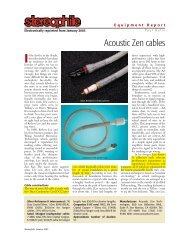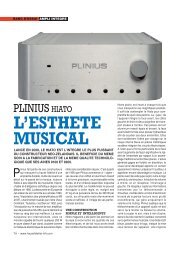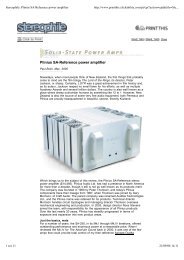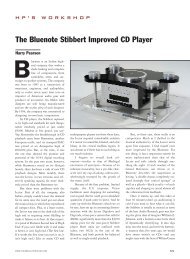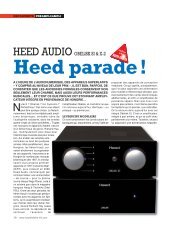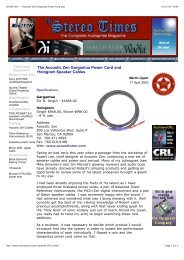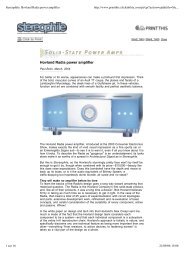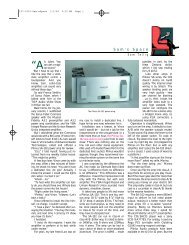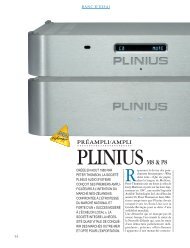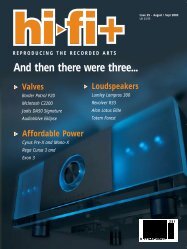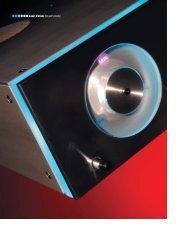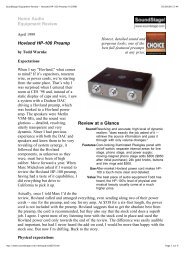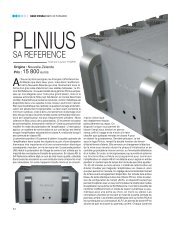Ultra High-Resolution "Acoustic Zen" Cables - Jason Diffusion
Ultra High-Resolution "Acoustic Zen" Cables - Jason Diffusion
Ultra High-Resolution "Acoustic Zen" Cables - Jason Diffusion
- No tags were found...
Create successful ePaper yourself
Turn your PDF publications into a flip-book with our unique Google optimized e-Paper software.
<strong>Ultra</strong> <strong>High</strong>-<strong>Resolution</strong> "<strong>Acoustic</strong> Zen" <strong>Cables</strong>From Cable-Design Legend, Robert LeeJim Merod18 September 2000SpecificationsSILVER REFERENCE: $898/one meter pairMATRIX REFERENCE: $498/one meter pairACOUSTIC ZEN TECHNOLOGIES858/487-742917557 MONTERO RD.SAN DIEGO, CA (92128)e-mail cableguy@cts.comWeb: www.acousticzen.com"Robert Lee's work with Harmonic Tech brought superior cables into themarket at a real-world price point. After I read Lee's 1998 'white paper'outlining his cable design philosophy, I asked him about the possibilities of"stretching the sonic envelope of cable design" further yet -- beyondanything available on the market."As a recording and mastering engineer, I can attest to the importance of carefulcable selection in the creation of recorded music. One of the surprising facts ofstudio recording operations is the prevalence of mid-grade and, often, inferiorcables. One finds long runs of low-end cables strung between expensive pieces ofgear throughout otherwise high-tech recording real estate.When state-of-the-art-mixing consoles are cabled with less than transparentpatches, microphone cables, and monitor feeds, the sonic result will fall short.Significant degrees of clarity and timbral delicacy that any musician, recordist, oraudiophile music lover should seek will never appear. Such lack or sonic absence isoften not detected since you cannot know what you are missing if you've neverheard it in the first place. The result, in one phrase, will be at best a compromisedsuccess. At the opening of a new century, a new series of advanced cable designs isset to enter the field of audiophile musical operations: ACOUSTIC ZENTECHNOLOGIES, Ltd.The "<strong>Acoustic</strong> Zen" line is the culmination of years of cable and sonic research byRobert Lee, the ground-breaking cable design engineer who spearheaded the use ofsingle-crystal copper wire configurations at Harmonic Technology. In addition to hismore than two decades of high-profile cable research work, Lee has long beenknown for his elegant amplifier circuit designs and for his limited-edition productionof extremely musical, high-resolution speakers that are champions at sound stagereproduction.Lee now brings thirty-plus years of research and development experience to the
creation of an innovative line of analogue and digital interconnects, speaker wire,and power cords. <strong>Acoustic</strong> Zen's "ultra high-resolution cables" use exotic puregrades of silver and copper wire. Lee calls the material that he is working with "zerocrystal" because each run of copper and silver wire in his new cables is drawn froma continuous metal crystal that reaches more than one hundred and twenty-fivemeters in length. Lee has found that the inherent structural integrity of suchmaterials, free of impurities, creates maximum signal coherence with the fewestdispersion artifacts.I have had several engaging conversations with Robert Lee about cable design overthe course of the past two years. When Lee designed and directed the emergence ofHarmonic Technology's line of cables, I reviewed his design work. Lee'sunderstanding of the behavior of transmitted musical signals is based upon literallythousands of hours of critical listening and several hundred signal deliveryconfigurations.Lee has created <strong>Acoustic</strong> Zen cables so that they can be refined to maximizeperformance in individual sound systems. Lee calls this feature of his new line ofcables "precise fine tuning." He explains that his soon to be published "<strong>Acoustic</strong> ZenDesign Philosophy" document will describe this additional feature.When I reviewed Harmonic Tech cables in 1998, I found them to be a good value.Their power cords are fine performers, too, almost up to the level of dynamicintegrity as the remarkable (and still little known) Silverline power cords. I am nowawaiting delivery of Harmonic's new power cord, brought forth after Lee's departurefrom that company, since I will soon look closely at the current state of powercords, including Robert Lee's new design for <strong>Acoustic</strong> Zen and cords from VansEvers, Kimber, Shunyata, Stealth, and ESP, among others.Robert Lee's work with Harmonic Tech brought superior cables into the market at areal-world price point. After I read Lee's 1998 "white paper" outlining his cabledesign philosophy, I asked him about the possibilities of "stretching the sonicenvelope of cable design" further yet -- beyond anything available on the market.Lee's characteristic humor and modesty serve him well, but I had to push a bit toget a detailed response. He suggested, somewhat obliquely, that "research canalways advance our knowledge in every field of sound delivery." Pressed further, hisaffable good humor came to the fore. A cable designer's mind, he told me, "isrestless day and night. I never stop trying new things. I want all the sound [that]we hear at live concerts to be caught by microphones when you record. In addition,I want all that sound in its whole power to be reproduced through my cables. I don'twant any compromise."Lee laughs as he tells you things such as this. He was, on that occasion, teasingsomeone he knew to be devoted to live recording work. But he was kidding on thesquare. I was pleased, therefore, when he called to tell me of his new company. Iasked if I could review his new cables and he delivered several pairs of <strong>Acoustic</strong> Zenzero crystal "Silver Reference" cables, two pairs of "Matrix Reference," one of hisbig, new power cords, and a one meter digital cable. Two more power cords arrivedlater. I began the long work of critical listening.There is nothing that immediately meets the eye to distinguish <strong>Acoustic</strong> Zen cablesfrom many others on the market. They are handsome and serious looking pieces ofequipment. One feels the bulk of material and the care with which they have beencrafted. But their telling difference emerges after visual inspection -- in the sound."When the first two pairs of <strong>Acoustic</strong> Zen cables went into my system(displacing, for this listening, a pair of Magnan and a pair of Harmonic Techcables), the soundstage both deepened and grew wider. It more fullyresembled the actual physical location where the music that I recorded wascaptured live-to-two-tracks."Immediately -- and I mean RIGHT AWAY upon installation -- the first pair of<strong>Acoustic</strong> Zen zero crystal "Silver Reference" interconnects changed, for the better,
the sonic envelope of my initial listening area. This occurred despite the fact thatthe cables, Lee told me, had not been broken in. He suggested that thirty hours ofpink noise would allow the wire to settle into its best sonic qualities.I followed Lee's advice and began to take notes after his wire had been burned infully. I kept in place the four-foot run of Magnan Vi single-ended cables that linked aConrad-Johnson "Premier Eleven" tube-amplifier to a custom-built cross-over for myCabasse Baltic-Stromboli speakers. Magnan wire has been a near-fixture in thatsystem for almost nine months of continuous critical listening in preparation for areview of the glorious C-J amp [to follow]. With the inclusion of the <strong>Acoustic</strong> Zencables, I not only heard more information from that large, stunning amplifier. Iheard how the cables handled musical signals. My long time listening and takingnotes on the C-J tube amp allowed me an unconfused view of what the new cablesbrought to the system.A significant difference was discernible right away at the top of the spectrum. The<strong>Acoustic</strong> Zen "Silver Reference" cables gave a greater sense of ease in the higherfrequencies (above 12 kHz) where a sense of "air" and room ambience are largelyconcentrated. This was particularly apparent with the exquisite cymbal work thatChico Hamilton executed on late-'50s recordings with his quintet (Pacific Jazzrecordings now re-issued on Mosaic Records). <strong>Acoustic</strong> Zen's upper end resolutionwas vivid, as well, in the reproduction of snare drum textures when Hamilton usedsoft mallets. The instrument's size and mass became fuller, more delicatelypercussive.Next, I replaced a one-meter single-ended pair of Harmonic Technology cables witha one-meter pair of Lee's zero crystal "Matrix Reference" interconnects. The <strong>Acoustic</strong>Zen wire then linked the output of my hand made Cabasse cross-over to a modifiedAudio Research LS-2a (tube) pre-amp. Everything that the Cabasse satellites andsub-woofers received, therefore, was now delivered from the new <strong>Acoustic</strong> Zencables.WHAM! Images that had already been holographically dead-on (a characteristic ofDave Magnan's Vi and Signature interconnects), images texturally-complex withmusical nuances, expanded and locked into even more vivid three-dimensionalresolution.The first track I played with two pairs of <strong>Acoustic</strong> Zen cables in the system was "IConcentrate On You," a gorgeous rendering by San Francisco vocalist Jackie Ryan,with Mike Wofford's trio, from an album soon to be released. This is a track that Iknow very well. I recorded it live-to-two-tracks at 24-bits using several tubemicrophone pre-amps. In addition, my colleague Steve McCormack and I workeddozens of late night hours to master it and eleven other songs on the album "ForHeaven's Sake," BluePort, [BP-J004].Nothing about the sound of this recording is foreign or mysterious to me. I had,literally, heard the music as it was being created, while it was recorded. After thosefleeting moments on two evenings of live performance, I had listened to this songat least eighty times during various stages of the selection, editing, and masteringprocess. Parts of the material had been inspected even more than that. I had, inaddition, heard the track on more than thirty high-end sound systems during theweeks that Steve and I were mastering it. I am aware of our exuberance and longhours. This is our work and our passion.I was somewhat startled by what I heard on my Cabasse system when the first pairof <strong>Acoustic</strong> Zen cables went into the network. I am understating the case. I wasmore than surprised by what I heard -- and surprised not only because individualsonic details previously blurred or buried stood forth with their own integrity.I was surprised, to the point of genuine amazement, hearing subtle musicalelements that had been obscured or absent … details that had never beforeemerged from this material on this system.The truth of the sonic change was larger than this statement suggests. The simplest
way to name the change is to say that I heard a MUSICALITY -- a presentation ofthe music's inner pace, with an utterly convincing rhythmic and harmoniccohesiveness -- from Jackie Ryan's stellar, mid-performance quartet that had neverbefore been delivered by this monitoring rig.A footnote is in order here. Recording studios routinely employ very long runs ofmicrophone cables as well as patch bay circuits and patch cords. The number oflinear feet of wire that sits between an artist's voice or instrument and the tapethat captures it can be measured in three figures or more. Despite the importance,and the prevalence, of cables in studio recording work, the vast majority ofrecording engineers adamantly believe that wire is wire -- that no difference can beheard among cables. Mogami is akin to Canare. Canare is equal to Belden, withClark or Monster no more, no less sufficient. A recent two day recordingengagement at a major Los Angeles studio once again confirmed this mind set. Oneis tempted to laugh … or cry.The assumption of cable equality is a joke. Sufficiency does not suffice. And onewonders, concluding such adventures, about the quality of home sound systemsused by those who feed the sound of great musicians through ordinary wire at thebeginning of your (and their own) listening pleasure.My Cabasse monitoring system has been set up to deliver a high degree of detail sothat I can hear as far into the sound chain as possible. I use it as part of mymastering playback work. It is one of several systems I rely on to work withrecordings, one of several used to review equipment, as well.I've found few rules of the audiophile road that are one hundred per cent certain,but I am sure of this one. The proof of great cables is in the details. I have neverencountered any interconnect that is utterly neutral, without tonal character. I doubtthere is or will be such an entity. Therefore, I take REVELATION of detail andACCURACY of musical representation to be a strong sign of virtue in interconnects.If the music being played through such wire is beautiful, (beautifully played,beautifully recorded) then the wire should deliver it beautifully and vividly.That predilection on my part has lured me to admire Nordost Quatro-fils cables aswell as Magnan cables. Very few interconnects that I have used combine rigorousanalytical revelation with extraordinary musicality. The best Magnan and Nordostcables do that. Others approach this ideal. I have long been a fan of AudioQuest"Diamond" cables for that reason.When the first two pairs of <strong>Acoustic</strong> Zen cables went into my system (displacing, forthis listening, a pair of Magnan and a pair of Harmonic Tech cables), the soundstageboth deepened and grew wider. It more fully resembled the actual physical locationwhere the music that I recorded was captured live-to-two-tracks. Such recordingsare in some sense fragile. When recordings are done well, they carry an explicitsense of the ambience in which music is created as musicians, in performance, digdeep into their inspired work.A single pair of <strong>Acoustic</strong> Zen cables increased the Cabasse system's transparency.Two pairs created a sense of intimacy and musical "palpability" that riveted me tothe listening chair. My experience at that moment was very much like being back atthe club, in person, the night that "I Concentrate On You" was recorded withmusicians less than twenty feet from my console -- using a twenty foot pair of"Diamond" mic cables, a thirty foot pair of Magnan, and a twenty-five foot pair ofvan den Hul cables.Notes that I took on the occasion of my first extended listening to the <strong>Acoustic</strong> Zencables capture observations otherwise lost. The first concrete result of hearing Zen's"zero crystal reference" cables was "added upper range clarity" and "deepenedsoundstage resolution." My scribbled notes point to "transient reverberation tailsthat linger eerily" and "quicker attack from vocal dynamics" as well as "solidity fromthe piano's percussive heft given added body and placement." The singer's "heightand presence," the notes say, "take on greater resolution than before."
There was more "there" to be heard and felt with the <strong>Acoustic</strong> Zen wire. I wasstruck by the liquid ease of Jackie Ryan's voice. The Zen cables seemed to cradleand adore middle registers, the rich harmonic core of musical feeling. When themidrange is right, everything else stands more solidly in musical perspective. TheZen wire seems to love the broad middle register of this singer's magnificentexpressive voice.As a reality check, I went back to the original configuration of cabling in order toverify my notes. My initial experience with the Zen wire left me somewhat perplexedor, at any rate, disbelieving. I was perplexed because such a stunning difference,next to the marvelous Magnan cables, was wholly unexpected. I was disbelieving, inpart, because ancillary differences -- the air's humidity and one's own mood oralertness, as immediate examples -- play a significant role in critical listening. Iwanted to be sure that such a graphic sonic change had truly emerged from thesimple act of swapping two pairs of very good (and steadfast, time-tested) cablesfor the Zen cables."The bottom line is this. While <strong>Acoustic</strong> Zen's pure silver cable has analmost magical ability to reproduce the smallest (most evanescent) sonicdetails I've ever heard, I'm not certain which of these two remarkableinterconnects I prefer. Each is relaxed and deeply revealing. They are bothmusically seductive."The bottom line on the difference became clear with ongoing listening. With the<strong>Acoustic</strong> Zen wire in the chain, the emotional connection between the ear andconsciousness became more intimate. I do not want to dwell here with theemotional impact of the Zen cables. Nonetheless, the seductive aspect of thesecables is very real. It does not occur at the expense of sonic accuracy.The surprise I first encountered on hearing an extremely familiar piece of musicrendered more life-like in precise ways that recreate the truth and feeling of theoriginal performance -- the event's musical textures and energy unfolding withrelaxed sonic ease from the master tape that holds it -- was, for me, unexpected.No doubt, surprise (by definition) is always unexpected. In this instance, theexperience was joltingly unexpected because the cables that routinely link this (andevery other) sound system that I use for mastering and post-mastering comparisonare, in fact, the best cables that I have ever been able to locate. Perhaps I valueinterconnects, cables, analog and digital wire, and all of the network paraphernaliathat an audio engineer must rely on simply because … I am an audio engineer.Without cable, no sound. Without good cable, bad sound.Therefore, my devotion remains steadfast in pursuit of the mysteries of cable andcable design. Let me itemize. I followed my initial scrutiny of the <strong>Acoustic</strong> Zencables by replacing every interconnect in my Cabasse-system with either one-meteror one-point-five meter runs of "Silver Reference" and/or "Matrix Reference." Mytrusted Magnan Vi cables came out. Nordost Quatro-fils cables came out, also. Zip,as well, to Robert Lee's previous cables from Harmonic Tech.The entire network of wire, including the digital cable to the Birdland "Odeon Lite"24-bit DAC, was now comprised of Zen wire. One by one, as Lee's cables went in,the sound of the master tape through the system, via a Tascam 24-bit recordingunit, grew more accurately complex -- true to the mic-feeds that hit the tape fromthe on-site mix.I have enormous respect for a few privileged cables. Over many years of use, intruth, I have felt "privileged" by their sonic integrity. In my estimation, Magnan Vicables carry a nearly unrivaled sonic coherence. Dave Magnan's "Signature" cablesare (also) unique, eccentric, and superb. Both of them represent genuine goldstandards for any cable designer. Their ability to discriminate frequency intervalsamong instrumental voicings -- and within the complex structure of the piano, aswell -- is unusual by any measure.Nordost Quatro-fils cables deliver excellent spectral extension. For the past two
years, I have regarded the Quatro-fils as part of my working equipment in the fieldand back in the studio. To the Nordost and Magnan cables, I'll add one more, lessrecognized (in truth under-recognized): van den Hul's "Thunderline," along with theircarbon-filament "Second," cables are truly magnificent (if, also, eccentric) cablesthat have no easy comparison.Alongside these top-end manufacturers of sonic nirvana, <strong>Acoustic</strong> Zen Technologies,Ltd. has now pitched its tent. When Robert Lee called to inform me of his ongoingresearch, and his new cable designs, I was interested because his record over manyyears is impeccable. I was not prepared for the simplicity and elegance of musicalreproduction that his new work has wrought. I can honestly say that, in the monthsthat I have listened to his pure "zero crystal" silver and (silver- copper) matrixcables, my relation to recording and mastering equipment has taken on a newdimension.I hear more of what I've recorded.I trust <strong>Acoustic</strong> Zen's cables. They have all the sonic fundamentals right: accuratetonality, spectral extension, dynamic range, coherence within (among) sonicregisters, textural delicacy, ambient openness, and that hard to define quality thatI'll call musical pace. The proof for me is in the recording of music. I now regard<strong>Acoustic</strong> Zen's cables as an unimpeachable standard for my own recording work. Ifthese wires were priced at the top, among the most expensive interconnects, Iwould not be at all surprised. They are not. How often, in the world of audiophileecstasy, do we find bargains? Seldom. Here you have one. <strong>Acoustic</strong> Zen cables arepriced lower than most high-end interconnects. Of the small group that I deemextraordinary, they are by far the least expensive. <strong>Acoustic</strong> Zen cables are the realdeal at a modest, no nonsense price.ConclusionNothing will dissuade me from my longstanding ambivalence about cables. They are,for me, necessary evils. I cannot live without them … in large numbers. Thus theneed for a negotiated settlement with some. These cables make such negotiationseasier.The bottom line is this. While <strong>Acoustic</strong> Zen's pure silver cable has an almost magicalability to reproduce the smallest (most evanescent) sonic details I've ever heard,I'm not certain which of these two remarkable interconnects I prefer. Each isrelaxed and deeply revealing. They are both musically seductive.Don't forget to bookmark us! (CTRL-D)



